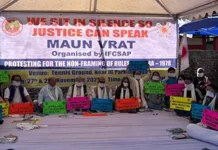Flights Of Fantasy
[ M Panging Pao ]
According to the latest Global Peace Index (GPI) rankings, India is ranked very low at 135 among 163 countries. Towards assessing peacefulness, GPI studies the extent to which countries are involved in internal, external conflicts, level of harmony or discord within a nation. The parameters includes factors like number/duration of internal conflicts, impact of terrorism, political instability, number of internal security officers/police per 100,000 people, number of homicides, level of violent crime, number of refugees/displaced persons as percentage of population, etc.
As per the present GPI rankings, Iceland remains the most peaceful nation and Afghanistan the least peaceful nation. As per the report, India’s ranking is below Bhutan, Sri Lanka, Nepal, Bangladesh (91), China (100) and Myanmar (131). In the subcontinent, only Pakistan and Afghanistan are below India.
Major religions that preach peaceful coexistence and tolerance, like Buddhism, Jainism, Hinduism and Sikhism, have originated in India. In fact, the father of the nation is Mahatma Gandhi, who preached ahimsa or non-violence. Many believe that Mahatma Gandhi’s ahimsa or non-violent movement finally led to India attaining freedom from British rule. Despite all these peaceful milestones, why is our great nation ranked so low in the peace index?
Internally we have ongoing violent conflicts in many states of central India, Jammu & Kashmir and Northeast India. Externally we have fought wars in 1948, 1962, 1965 and 1971. There were armed interventions in Sri Lanka, Maldives and armed conflicts like the Kargil operations, Operation Parakram, the Mumbai terror attacks, etc.
What about Northeast India and Arunachal? The Northeast has several antinational groups, sectarian groups, racial/religious conflicts, interstate border disputes, refugee crisis, etc. Several groups are running parallel economies, increasing financial, social and political burden on the common citizens. Various types of bandhs are frequently seen in the Northeast and Arunachal. There is a bandh culture prevalent in the region and numerous groups call and implement bandhs at short notice. Bandhs disrupt public life, adversely impact the economy, closes schools/colleges and are regressive by nature. The common citizens and daily wage earners suffer the maximum. Peace and stability of our societies are frequently disrupted.
Are we quarrelsome and intolerant? Are we short-tempered and aggressive? Are our lives dominated by tension and anxiety? Are our lives dominated by protests, conflicts and violence that our country is rated so low in the peace index? Developed nations are more disciplined, cleaner, systematic, less chaotic, and peaceful. In comparison, developing countries and states are dirtier, chaotic, corrupt and prone to conflicts.
Most of our news headlines on TV, print media and social media are dominated by violent news, protests, religious/racial conflicts, political slugfests. Today’s news channels are like boxing matches with all participants and anchors shouting over each other.
Do we want to live peaceful and happy lives in Northeast India and Arunachal? Isn’t it time that India, the Northeast and Arunachal strive towards more peace and stability in society? We need more ‘Gandhigiri’ to improve our peace index. (The contributor is retired Group Captain, Indian Air Force)


